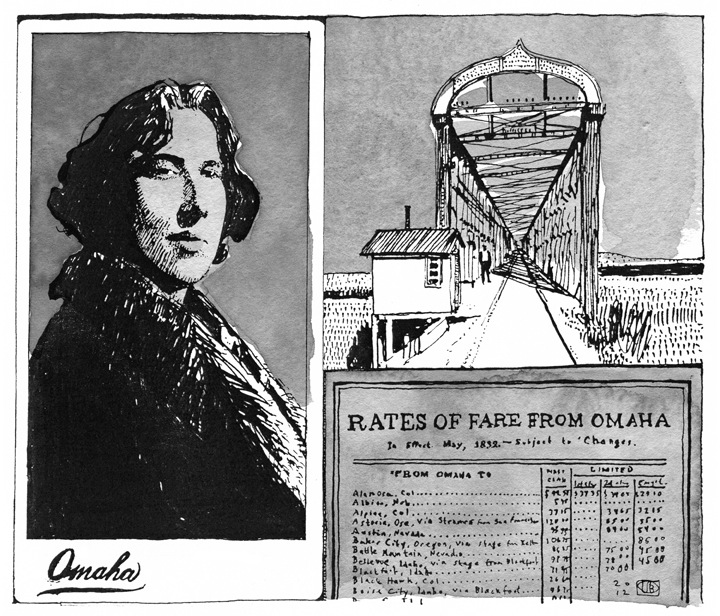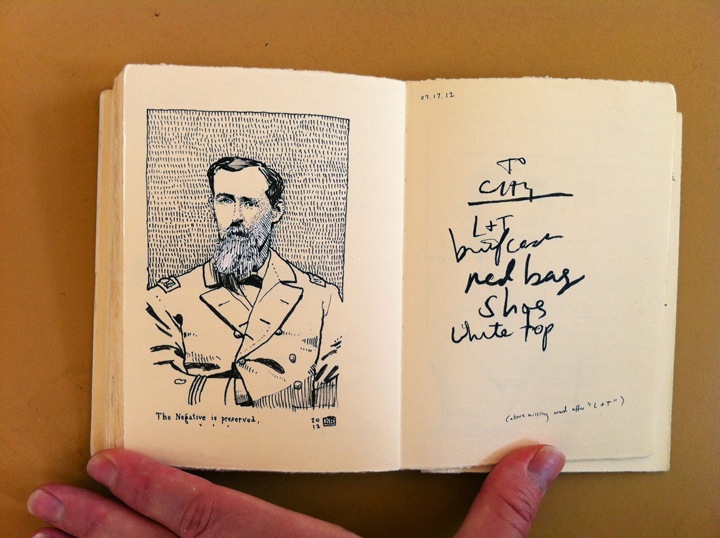Lauren Simkin Berke: The DART Q&A
Lauren Simkin Berke is a hands-on artist from the ground up. What I mean by this is: She draws like a demon [on paper!], and digs through bins of vintage photos and ephemera at flea markets and elsewhere to find reference material for her art. She recently took time away from her work to do the DART Q&A. Here’s what she wrote:
As an artist, what are some of your favorite things about living and working in Brooklyn?
I love the energy and pace of Brooklyn, which is mellower than Manhattan. Living here allows me access to more light, sky, and clouds, while being close to the material and human resources Manhattan offers.
How and when did you first become interested in art and illustration?
Drawing is my first and most fluent language. While art has always been a part of my life, the idea of illustration as a career didn't occur to me
until my last year of college, when a visiting artist made a remark about representational artists “just being illustrators.” Despite the snideness of his statement, this made me
realize that as a representational artist I could have a somewhat "practical" commercial illustration/art career, in conjunction with my personal/gallery work.
Tells us about your art/design background. Where did you study? What was your experience there like?
I spent a year in Cornell University’s BFA program (in the college of Architecture, Art & Planning), but was bored and frustrated when they wouldn’t let me take second year courses on top of the 1st year curriculum. I switched to Cornell’s college of Arts and Sciences, and ended up with a BA in Anthropology. Then I went into SVA’s Illustration as Visual Essay MFA program, which was fantastic. The program has a faculty of amazing storytellers, from a wide range of arts backgrounds. I went in knowing nothing about the business of illustration and came out having a solid sense of what I needed to do to build a freelance art career.
What is your favorite part of the creative process?
Seeing what the unconscious mind can do when you get out of its way.

Do you keep a sketchbook? What is the balance between art you create on paper versus what you do in the computer?
I’ve kept a sketchbook since I was quite young. I have a daily practice of drawing freehand from vintage photos. It started as a 5-7 day a week thing, but is now more like 3 a week. I started a blog in 2006 as an archive of these drawings, and have just made my 1200th post.
I make work on paper, wood or canvas. For illustration jobs, I do ink drawings and on a separate surface watercolors or collages, and combine them in photoshop. In my personal work I use a few processes to lay line over color, mainly xerox transfer for small work and traced projection for large work.
What was the biggest mistake you've made and what did you learn from it?
I chose to attend Cornell University because I thought it was a smart and practical choice, instead of Reed College, which I was in love with. From an academic perspective I would have finished college more developed as an artist had I gone to Reed. That being said, there are many great things that came from that mistake: I lived and worked in a castle (Risley Residential College for the Creative and Performing Arts), I was able to take some amazing courses, such as The Social Construction of Gender and Sexuality with Sandra Bem, and Race, Power and Privilege in the United States with Don Barr and James Turner, and I made friends that I would not want to imagine my life without. I learned that all experience is valuable, that what you bring dictates a lot of what you learn, and that even what seems like the biggest mistake is not such a big deal, in the grand scheme of things.
What are you listening to?
I’m in the midst of an obsession with Arthur Russell, which started with the soundtrack for the film Keep the Lights On (2012). Really beautiful and haunting music that combines classical, electronica and folk.
Who and what are some of your strongest influences?
I'm influenced by late 19th and early to mid 20th century photography, which I use as reference for my work, and is a huge influence on the kinds of compositions I'm interested in. I'm also influenced by the way color functions in silkscreen printmaking. People who have influenced me: Alice Neel, Ray Johnson, Egon Schiele, Gustav Klimpt, John Hughes, Bruce Weber, Andy Warhol, Roland Barthes, Ursula K. Le Guin, Diane Arbus, Annie Leibovitz, though there are many more. They are painters, photographers, drawers, writers, filmmakers and philosophers; really just people who thoroughly examine and explore their interests, who focus on things that most people don't pay attention to, or things people think of as givens that are really choices and products of a particular society, culture and period. The thing that has influenced me most is my favorite book, The Alien Diaries by Maris Bishofs, which I've had since I was eight years old.
What are some of your favorite blogs/websites for inspiration?
I watch the new TED talk videos posted \ pretty much every day, and I like watching documentaries, so netflix.com is one of my favorite sites. When I need to cheer up, I go to muffinfilms.com, and watch Bluebirds in the Spring.
Where did the idea for your book To Be Kept originate? What was the most difficult part about getting from idea to the finished piece?
To Be Kept is an extended catalog I published last fall, for an exhibit I had the previous winter at Accola Griefen Gallery. The book was a way for this particular collection of work to live together beyond the exhibit itself, while showing the work in a larger context than one would have seen from viewing the show. What was most difficult was learning InDesign, as I designed the book myself, and had previously only ever cobbled books together in Photoshop.
The printing of To Be Kept was
funded through a Kickstarter campaign that was made successful by 100 backers, many of whom are friends and
family, but also include people who are newcomers to my work. The funds covered the cost of having 500 copies printed, as well as creating and shipping backer rewards. The book is available on
my etsy shop, at the Society of Illustrators’ museum shop, and a few independent booksellers. Information.
Is there any particular new technology you’ve embraced as an avenue towards entrepreneurial adventures?
The combination of easier access to digital printing resources, relatively easy-to-use publishing software (InDesign) with crowd-sourced funding (Kickstarter) allowed me to test out being my own publisher, and in effect start my own press (Captain Sears Press).
Has social media been a boon for self-promotion? Or do you have methods you’ve always used that still work?
There is no substitute for the use of promotional mailers: booklets, postcards and the like. I love getting mail, and I imagine art directors do too, especially when it feels personal, beautiful and precious (without being nauseatingly so), and that’s what I try to do.
What advice would you give to a young illustrator who is just getting noticed?
To consistently make time to do work for yourself, even if just for a half hour a day, so that your instincts and explorations drive the direction of your work and career.
Lauren Simkin Berke is a Brooklyn based artist and illustrator whose work can be seen in galleries, on book covers, and in publications such as The New York Times, The Boston Globe, and the L.A. Times. With drawn lines that overlay swaths of color, Lauren's work explores instinctive color play combined with drawn images that study human gesture and how people document their lives in photographs. Lauren has been recognized by the Society of Illustrators, Communication Arts, Print Magazine, and American Il. lustrationLauren is represented by Riley Illustration and Accola Griefen Gallery. Her work will be featured in the August 2013 issue of Print Magazine, as one of the winners in the 2013 Hand Drawn competition.





